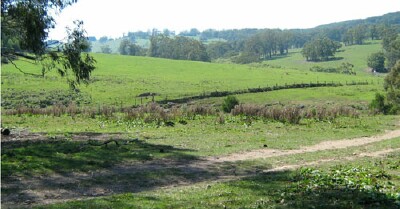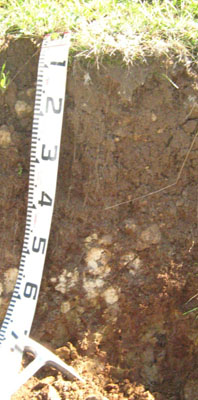EGW43
Location: Gelantipy
Australian Soil Classification: Haplic, Eutrophic, Red FERROSOL (Stony)
Map Unit: W Tree (Component 1)
Previous Site Name: EG43
General Landscape Description: Dissected plateau
Site Description: Upper hill-slope, northerly aspect
Land Use: Grazing
Native Vegetation: Montane grassy woodland
Geology: Tertiary basalt

Soil Profile Morphology:
| A11 | 0 – 5 cm | Dark reddish brown (5YR3/2); loam; weak fine polyhedral structure; weak consistence moderately moist; few subangular basalt cobbles; clear change to: |  |
| A12 | 5– 30 cm | Reddish brown (5YR4/3); clay loam; moderate coarse polyhedral structure, parting to medium polyhedral structure; firm consistence dry; few subangular basalt cobbles; pH 6.2; clear change to: | |
| Subsoil | |||
| B | 30 – 60 cm | Dark reddish brown (2.5YR3/3); medium clay; coarse polyhedral structure parting to medium polyhedral structure; very firm moderately moist; common subangular basalt cobbles; pH 6.4. Weathering rock at 70 cm. |
Key Profile Features:
- Weak texture contrast between the surface soil (A11 and A12) and the subsoil B
- Moderately shallow profile depth to weathered rock.
Soil Profile Characteristics:
- | pH | Salinity | ||
Surface soil (A11 horizon) | Slightly acid | Very low | Non sodic | None |
Subsoil (B horizon) | Slightly acid | Very low | Non sodic | None |
Chemical and Physical Analysis:
Horizon | Horizon Depth (cm) | pH (water) | pH (CaCl2) | EC dS/m | Organic Carbon % | Total Nitrogen % | Free Fe2O3 % w/w | Exchangeable Aluminium ppm | Exchangeable Acididty meq/100g | Exchangeable Cations | Coarse Sand (0.2-2.0 mm) % | Fine Sand (0.02-0.2 mm) % | Silt (0.002-0.02 mm) % | Clay (<0.002 mm) % | Field Capacity % w/w | Wilting Point % w/w | |||
Ca | Mg | K | Na | ||||||||||||||||
meq/100g | |||||||||||||||||||
A12 | 5-30 | 6.2 | 5.5 | 0.07 | 1.4 | 0.9 | 3.4 | <1 | 7.8 | 5.7 | 3.2 | 1.2 | <0.05 | 13 | 34 | 32 | 22 | 28.4 | 10.3 |
B | 30-60 | 6.4 | 5.6 | 0.06 | 5.1 | <1 | 11.0 | 9.3 | 7.0 | 1.5 | 0.07 | 5 | 23 | 27 | 43 | 36.3 | 19.8 | ||
Management Considerations
Whole profile
- The profile is slightly acid throughout.
- These soils are very well drained due to their strongly developed subsoil structure.
- Plant available water capacity is considered to be low estimated at 70 mm based on the laboratory data, the presence of cobbles in the subsoil and the shallow nature of the soil profile.
- The immediate subsurface soil has low organic matter content. Organic matter will be better maintained under rotational grazing, which enables stronger pasture recovery, rather than set stocking.
- The nutrient holding capacity of the soil is moderate (based on the sum of the exchangeable basic cations).
- Although the soils are fairly high in iron oxide, the pH is high enough to minimise phosphorus fixation.
- Potassium levels are very high and no response to potassium fertilisers would be expected.
- The nature of the subsoil allows deep penetration of plant roots.
- The nature of the subsoil together with the shallow depth to rock, can lead to problems with sealing of earth dams.
Profile Described By: David Rees and Grant Boyle, 2000.


